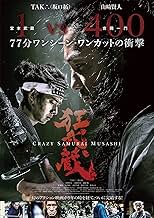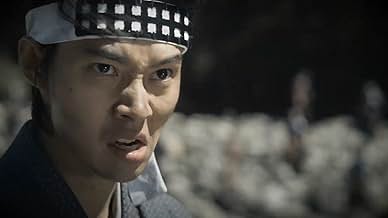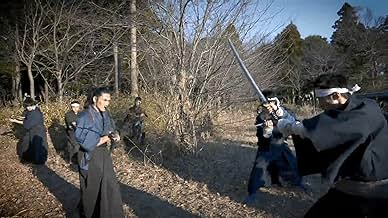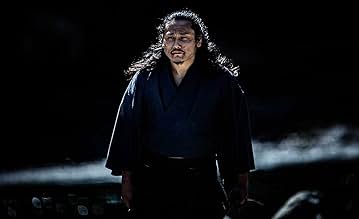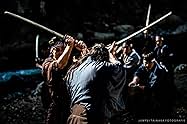IMDb RATING
4.6/10
1.1K
YOUR RATING
The most famous battle of the swordsman Miyamoto Musashi. Miyamoto fights against 588 enemies, one after the other. There is no room for error, no room for trivial, outdated, or unconvincing... Read allThe most famous battle of the swordsman Miyamoto Musashi. Miyamoto fights against 588 enemies, one after the other. There is no room for error, no room for trivial, outdated, or unconvincing movements.The most famous battle of the swordsman Miyamoto Musashi. Miyamoto fights against 588 enemies, one after the other. There is no room for error, no room for trivial, outdated, or unconvincing movements.
- Director
- Writer
- All cast & crew
- Production, box office & more at IMDbPro
Featured reviews
Crazy Samurai: 400 vs. 1, also known as Crazy Samurai Musashi, is based upon writer, swordsman, strategist, ronin and philosopher Musashi Miyamoto who has inspired numerous legends. This low-budget movie shows how the titular hero confronts four hundred swordsmen when arriving to duel the disgraced Yoshioka dojo.
This movie can be separated into three scenes. The first scene is filled with atmosphere, context and tension as the members of the disgraced dojo expect the swordsman to arrive. They are planning on ambushing him but are obviously underestimating their enemy's wit.
The second scene has been filmed in one single take and lasts for seventy-seven minutes. Musashi Miyamoto confronts his enemies. They fight in a forest, on a field, in a house, in a court and later on in a small village. There are a few elements that offer some short breaks from the fight sequences such as the protagonist's brief monologues, the argument between two samurai and a peasant girl who betrays the hero.
The final scene takes place several years after the events portrayed before. It shows us what Musashi Miyamoto has become and what his foes are willing to do to murder him for once and for all.
The movie title already indicates exactly what you get here. This film is filled with fight scenes from start to finish. The stamina of lead actor Sakaguchi Taku is quite remarkable. The beautiful locations bring to life Japan in the early seventeenth century. Some of the fight scenes end up being a little bit repetitive. The visual effects look quite cheap but one gets used to them. The ending of the second scene felt a little bit unfinished in my opinion but didn't have an overall negative impact.
To keep it short, this movie is only interesting for martial arts enthusiasts and people who are interested in Japanese culture, history and legends. The movie has an unusual approach which makes it interesting to watch despite some repetition here and there. You should not expect witty dialogues, profound plot and unexpected twists here. Genre fans will get what they want and everyone else should simply ignore this film.
This movie can be separated into three scenes. The first scene is filled with atmosphere, context and tension as the members of the disgraced dojo expect the swordsman to arrive. They are planning on ambushing him but are obviously underestimating their enemy's wit.
The second scene has been filmed in one single take and lasts for seventy-seven minutes. Musashi Miyamoto confronts his enemies. They fight in a forest, on a field, in a house, in a court and later on in a small village. There are a few elements that offer some short breaks from the fight sequences such as the protagonist's brief monologues, the argument between two samurai and a peasant girl who betrays the hero.
The final scene takes place several years after the events portrayed before. It shows us what Musashi Miyamoto has become and what his foes are willing to do to murder him for once and for all.
The movie title already indicates exactly what you get here. This film is filled with fight scenes from start to finish. The stamina of lead actor Sakaguchi Taku is quite remarkable. The beautiful locations bring to life Japan in the early seventeenth century. Some of the fight scenes end up being a little bit repetitive. The visual effects look quite cheap but one gets used to them. The ending of the second scene felt a little bit unfinished in my opinion but didn't have an overall negative impact.
To keep it short, this movie is only interesting for martial arts enthusiasts and people who are interested in Japanese culture, history and legends. The movie has an unusual approach which makes it interesting to watch despite some repetition here and there. You should not expect witty dialogues, profound plot and unexpected twists here. Genre fans will get what they want and everyone else should simply ignore this film.
A good samurai movie. It does contain the longest fighting sequence, in a single shot! Fighting does feel repetitive, but you can't compare it to anything else, cuz no one else did the same thing.
Real dedication showcased. I wish they had longer first and last scenes, and a shorter fighting sequence in between.
Personally I enjoyed the movie, but to review this or recommend the movie, I would not.
I had no idea Tak was the leading actor, and I knew it would not disappoint. Though it let me down.
The opening of the movie felt like a real movie, the camera, cinematography, colour grading, blurring etc. As soon as someone gets killed and Musashi reveals himself, then the quality all of a sudden drops.
I was shocked that the movie did the action one take with no cuts, effects or cgi. However it got repetitive, which was the movie's downfall. Same moves, same attacks, same sequences. I can understand it would be hard to find 400 actors and 400 actors who can remember the choreography and cut time, so it's fine for me if the same actors where repeating.
The movie had little story, which was a downfall, we have no idea why Musashi is killing the clans or why they want to kill him (because he killed someone Sejuiro). The effects of the movie are actually quite good, blood is not over exaggerated, but believeable.
The one shot take was cool, but very boring. I was just surprised how Tak could go on and on, which was an impressive human feat, this should go on the Guinness Book of World Record. Music were good choice, there was lack of acting.
The ending fight scene felt better than all the 70mins 1shot take.
Would I recommend this movie? No.
But I would advise you to watch if you like Samurai, Tak or one shot takes.
I had no idea Tak was the leading actor, and I knew it would not disappoint. Though it let me down.
The opening of the movie felt like a real movie, the camera, cinematography, colour grading, blurring etc. As soon as someone gets killed and Musashi reveals himself, then the quality all of a sudden drops.
I was shocked that the movie did the action one take with no cuts, effects or cgi. However it got repetitive, which was the movie's downfall. Same moves, same attacks, same sequences. I can understand it would be hard to find 400 actors and 400 actors who can remember the choreography and cut time, so it's fine for me if the same actors where repeating.
The movie had little story, which was a downfall, we have no idea why Musashi is killing the clans or why they want to kill him (because he killed someone Sejuiro). The effects of the movie are actually quite good, blood is not over exaggerated, but believeable.
The one shot take was cool, but very boring. I was just surprised how Tak could go on and on, which was an impressive human feat, this should go on the Guinness Book of World Record. Music were good choice, there was lack of acting.
The ending fight scene felt better than all the 70mins 1shot take.
Would I recommend this movie? No.
But I would advise you to watch if you like Samurai, Tak or one shot takes.
Miyamoto Musashi was a very interesting Japanese Ronin in Japan's era's of swordsmen and Samurai history. Throw in Tak Sakguchi playing Musashi and I was all set for an amazing action film. How wrong I was!
It dragged on and on with poor fight choreography and too few extras playing his enemies (it became very apparent, after 10 minutes, that the same dead guys were coming back time and time again). There were no exiting moments, no edge of your seat grippers but, there were many sword style errors; which in real life he would have been killed.
Overall i think it was poorly conceived, directed and acted with terrible choreography.
A brief HISTORY of the warrior who was the Bruce Lee of ancient Japanese swordsmen. Miyamoto Musashi, also known as Shinmen Musashi no Kami Fujiwara no Harunobu, Shinmen Takezo, Miyamoto Bennosuke or, by his Buddhist name, Niten Doraku, was a Japanese swordsman, philosopher, strategist, writer and Ronin. Musashi, as he was often simply known, became renowned through stories of his unique double-bladed swordsmanship and undefeated record in his 61 duels. He is considered a Kensei, a sword-saint of Japan. He was the founder of the Niten Ichi-ryu, or Nito Ichi-ryu, style of swordsmanship, and in his final years authored The Book of Five Rings and Dokkodo. Both documents were given to Terao Magonojo, the most important of Musashi's students, seven days before Musashi's death. The Book of Five Rings deals primarily with the character of his Niten Ichi-ryu school in a concrete sense, i.e., his own practical martial art and its generic significance; The Path of Aloneness, on the other hand, deals with the ideas that lie behind it, as well as his life's philosophy in a few short aphoristic sentences. Born:Shinmen Bennosuke, c.1584, Harima Province or Mimasaka Province, Japan. Died:June 13, 1645, Higo Province, Japan.
A brief HISTORY of the warrior who was the Bruce Lee of ancient Japanese swordsmen. Miyamoto Musashi, also known as Shinmen Musashi no Kami Fujiwara no Harunobu, Shinmen Takezo, Miyamoto Bennosuke or, by his Buddhist name, Niten Doraku, was a Japanese swordsman, philosopher, strategist, writer and Ronin. Musashi, as he was often simply known, became renowned through stories of his unique double-bladed swordsmanship and undefeated record in his 61 duels. He is considered a Kensei, a sword-saint of Japan. He was the founder of the Niten Ichi-ryu, or Nito Ichi-ryu, style of swordsmanship, and in his final years authored The Book of Five Rings and Dokkodo. Both documents were given to Terao Magonojo, the most important of Musashi's students, seven days before Musashi's death. The Book of Five Rings deals primarily with the character of his Niten Ichi-ryu school in a concrete sense, i.e., his own practical martial art and its generic significance; The Path of Aloneness, on the other hand, deals with the ideas that lie behind it, as well as his life's philosophy in a few short aphoristic sentences. Born:Shinmen Bennosuke, c.1584, Harima Province or Mimasaka Province, Japan. Died:June 13, 1645, Higo Province, Japan.
Very cool to pull a "one shot" off, but man did it ever trade that for the things I expect in a hardcore samurai movie. Not even ONE decapitation. So sad...
Did you know
- TriviaActor Tak Sakaguchi broke one finger, one rib and four of his teeth during the 77 minute battle sequence.
- GoofsMusahashi couldn't have known where to immediately find something to drink for each of his several breaks in a deserted village on the other clan's turf.
- How long is Crazy Samurai Musashi?Powered by Alexa
Details
- Release date
- Country of origin
- Official site
- Language
- Also known as
- Crazy Samurai: 400 vs. 1
- Production companies
- See more company credits at IMDbPro
- Runtime1 hour 31 minutes
- Color
- Aspect ratio
- 1.78 : 1
Contribute to this page
Suggest an edit or add missing content


